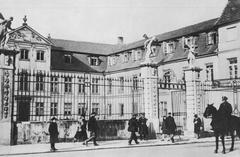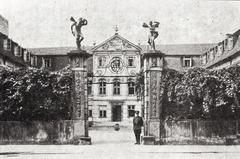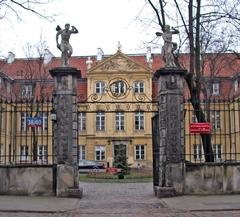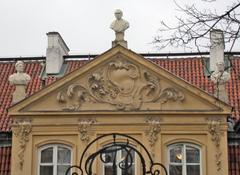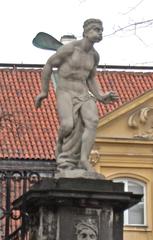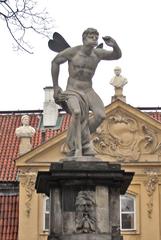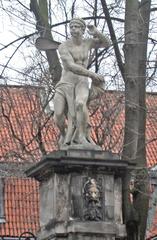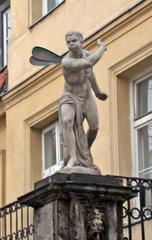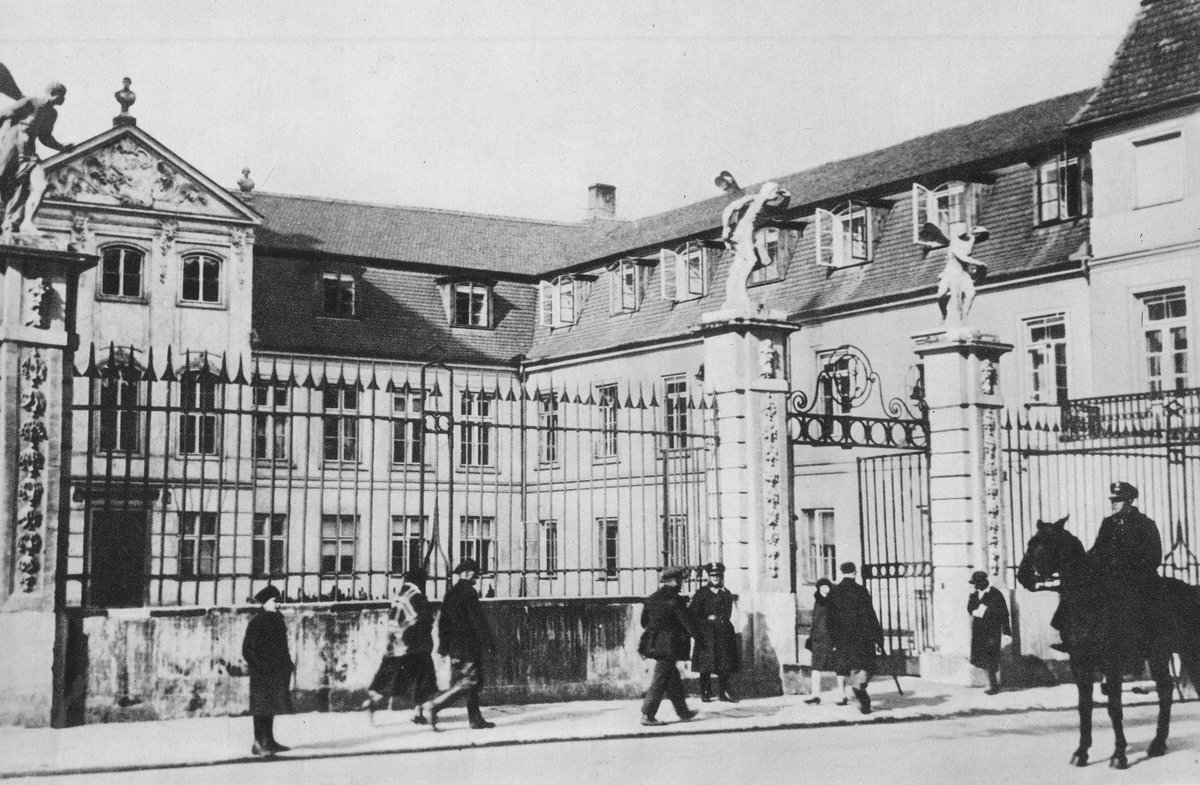
Palace of the Four Winds Warsaw: Visiting Hours, Tickets, and Historical Guide
Date: 14/06/2025
Introduction: The Palace of the Four Winds—A Warsaw Icon
The Palace of the Four Winds (Pałac Pod Czterema Wiatrami) is a luminous facet of Warsaw’s Baroque heritage, offering a compelling narrative of Poland’s aristocratic traditions, architectural evolution, and cultural resilience. Located at 38/40 Długa Street, this palace is renowned for its allegorical sculptures representing the four cardinal winds—an enduring symbol of the city’s cosmopolitan spirit during the Polish-Lithuanian Commonwealth era. Constructed in the late 17th century and attributed to Tylman van Gameren, the Dutch-Polish architect behind many of Warsaw’s iconic buildings, the palace stands as a testament to the fusion of Italian, Dutch, and French influences that shaped Warsaw’s aristocratic Baroque style (Warsaw City Guide, Explore Warsaw).
Though its interiors are largely inaccessible today due to governmental use, the Palace of the Four Winds captivates visitors with its restored façade, elegant courtyard, and the striking wind sculptures that crown its gate. This guide presents the palace’s fascinating history, detailed architectural features, practical visitor information, and tips for exploring one of Warsaw’s most evocative landmarks.
Table of Contents
- Historical Origins and Architectural Significance
- The Palace Through the Ages: Nobility, War, and Modernity
- Architectural Features and Artistic Legacy
- Visiting the Palace: Hours, Tickets, Accessibility
- Nearby Attractions and Visitor Tips
- Frequently Asked Questions (FAQ)
- Plan Your Visit and Stay Connected
- References
Historical Origins and Architectural Significance
Baroque Beginnings
Commissioned in the late 17th century for Stanisław Kleinpoldt-Małopolski, a royal secretary, the palace’s design is attributed to Tylman van Gameren (Wikipedia). Its iconic identity comes from the four mythological wind statues—Boreas (North), Zephyrus (West), Notus (South), and Eurus (East)—installed above the entrance gate in the 1730s. These allegorical figures reflected the Baroque fascination with classical mythology and the natural world (Blog Przewodników Warszawskich).
Architectural Style
The palace is a quintessential example of Warsaw’s Baroque and Rococo architecture, with a symmetrical brick and stucco façade, tall windows framed by ornate moldings, and a central avant-corps crowned by the four winds. The layout includes a central block flanked by wings and a formal courtyard, integrating Italian, Dutch, and French design elements (Explore Warsaw). Later renovations, particularly by Szymon Bogumił Zug, introduced Neoclassical touches for banker Piotr Tepper in the late 18th century (everything.explained.today).
The Palace Through the Ages: Nobility, War, and Modernity
Aristocratic Residence and Political Hub
Throughout the 18th century, the Palace of the Four Winds served as a prestigious residence, hosting nobility, bishops, senators, and even the king. Its halls were the scene of diplomatic salons and elite gatherings—reflective of Warsaw’s vibrant social and political life in the era (Blog Przewodników Warszawskich).
Transformation in the 19th and 20th Centuries
By 1801, the palace became Hotel Drezdeński, reflecting the city’s modernization and changing needs. It later housed the Warsaw Self-Government Assembly and, from 1927, the Ministry of Labor and Social Welfare (Klimat Warszawy). The palace was deliberately burned by occupying forces in 1944 after the Warsaw Uprising, but its robust masonry allowed for restoration (Wikipedia).
Postwar Restoration and Modern Use
After World War II, Warsaw’s Old Town underwent extensive reconstruction, earning UNESCO World Heritage status in 1980 (UNESCO Old Town). The Palace of the Four Winds was preserved and restored, its sculptures returned, and today it functions primarily as a government office, symbolizing Warsaw’s resilience and commitment to heritage preservation.
Architectural Features and Artistic Legacy
Exterior Highlights
- Façade: Symmetrical, with decorative pilasters, stucco, and a central section crowned by a pediment.
- Sculptures: The four wind statues (replicas), perched atop the gate, are rare in Warsaw’s garden art and symbolize cosmopolitan aspirations.
- Courtyard: Baroque arcades and brickwork create a refined entrance.
Interior and Artistic Details
While interiors are closed to the public, surviving elements include original frescoes, parquet floors, marble fireplaces, and a grand staircase with wrought-iron balustrades. Archival engravings and restoration photos highlight the palace’s rich artistic program (Explore Warsaw). The interplay of light, shadow, and mythological motifs underscores the building’s Baroque drama.
Gardens and Urban Context
Originally complemented by formal French-style gardens, today only traces remain, but the palace’s urban setting near Warsaw’s New and Old Towns situates it within a network of historic landmarks (Wikipedia).
Visiting the Palace: Hours, Tickets, Accessibility
Location
- Address: ul. Długa 38/40, Warsaw
- Nearest Metro: Ratusz Arsenał (Line M1), 5-minute walk
Visiting Hours
- Exterior Viewing: The palace’s façade and courtyard can be admired from the street year-round, at any time.
- Interior Access: Not open to the public due to its function as a government office.
Tickets
- Admission: Free to view the exterior and courtyard.
- Guided Tours: While the palace does not offer its own tours, many city walking tours include it as a highlight (Nomadic Matt).
Accessibility
- Exterior: The courtyard and surrounding streets are generally accessible for visitors with mobility challenges.
- Interior: No public access.
Travel Tips
- Best Times for Photography: Early morning or late afternoon, especially in spring and autumn, for optimal light.
- Public Transport: Well-connected by trams, buses, and metro; parking is limited.
- Respect: Do not climb the fence or statues; admire from designated areas.
Nearby Attractions and Visitor Tips
- Royal Castle: Reconstructed royal residence with guided tours (Away to the City).
- Saxon Garden: One of Warsaw’s oldest parks, perfect for a stroll (Wanderlog).
- Krasiński Palace: Another Baroque gem with gardens and exhibitions (Wikipedia).
- Warsaw Old Town: Vibrant UNESCO-listed area nearby (Nomadic Matt).
Frequently Asked Questions (FAQ)
Q: Can I visit the interior of the Palace of the Four Winds?
A: No, the interior is not open to the public due to its current administrative function.
Q: Are tickets required to visit?
A: No tickets are needed to view the exterior and courtyard.
Q: Are guided tours available?
A: Several city walking tours include the palace as a highlight.
Q: Is the palace accessible to visitors with disabilities?
A: The exterior and immediate surroundings are accessible.
Q: When is the best time to visit?
A: Early mornings or late afternoons in spring or autumn for the best lighting and pleasant walks.
Plan Your Visit and Stay Connected
Experience the enduring legacy of the Palace of the Four Winds—an architectural and historical jewel in the heart of Warsaw. Enhance your visit with the Audiala app for interactive maps, audio guides, and up-to-date event information. Follow us on social media to stay informed about Warsaw’s cultural events and heritage news.
References
- Warsaw City Guide
- Explore Warsaw
- Wikipedia: Palace of the Four Winds
- Klimat Warszawy
- Blog Przewodników Warszawskich
- everything.explained.today
- UNESCO Old Town
- Warsaw City History
- Miaster.pl
- Nomadic Matt
- Away to the City
- Wanderlog
- AB Poland Travel
Experience Warsaw’s historic grandeur—plan your visit to the Palace of the Four Winds and explore more of the city’s remarkable past with our curated guides.
